Christopher David Hynes doesn’t buy his art supplies — he finds them in junkyards. Using old scrap metal, broken machine parts, and clay, he creates amazing animal sculptures that look both strong and delicate at the same time.
His artwork shows a mix of nature and man-made materials. By combining hard metal with soft clay, Hynes creates animals that seem like they’re caught in motion — almost alive, yet part machine.
Each sculpture tells a story. They make us think about how machines and nature are connected, and what we might be losing in the modern world.
#1
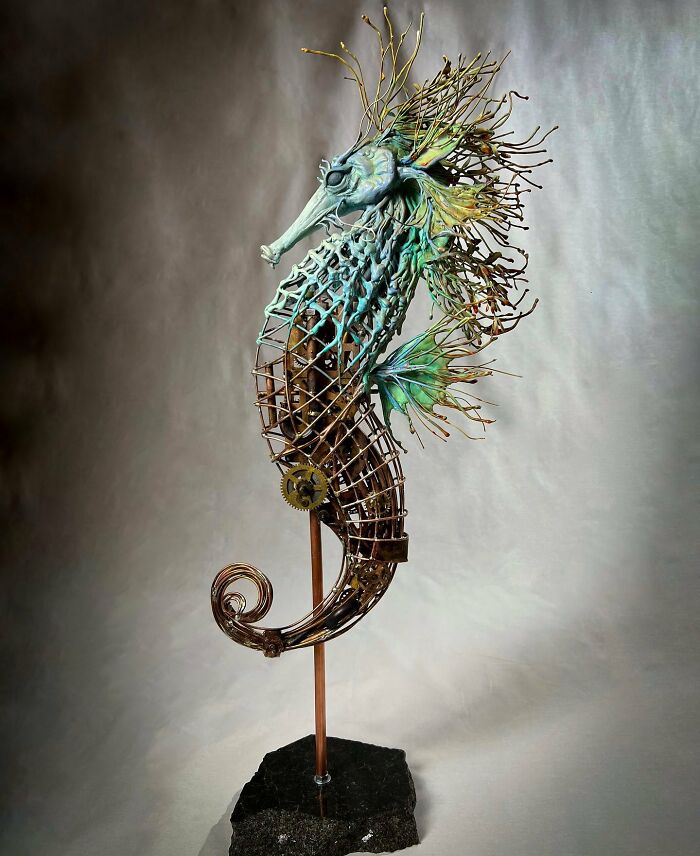
“This sculpture is a combination of found objects and clay, which began as some antique clock parts I had lying around. I have (if I recall correctly) three other seahorse sculptures in private collections; however, this is my first attempt at combining a more ‘organic’ look to the upper extremities. It’s always fun to experiment with these sculptures, and I hope that I never grow tired of exploring curiosities.”
#2

“Anglerfish I made from scrap parts found in a local junkyard. Added a light and put on a dimmer switch to make it a perfect night light for any child’s nursery.”
#3
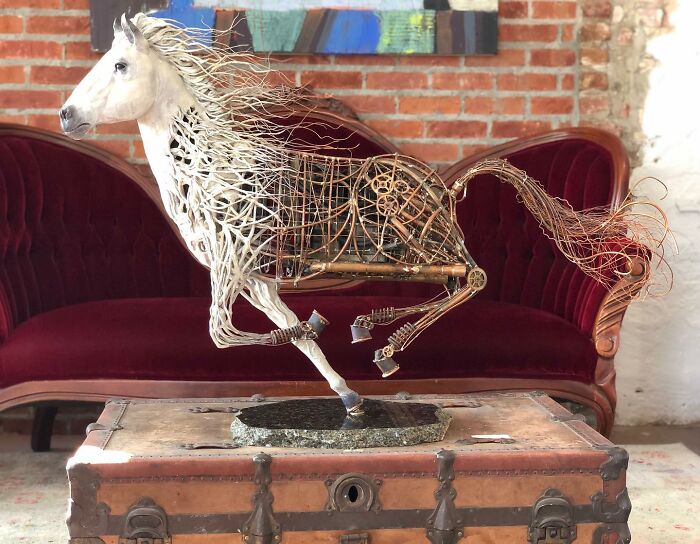
“What do you do with an old carburetor from a ’69 Ford Mustang Fastback? Make a horse, of course! This is the largest sculpture I’ve done to date. Weighing 50 lbs and about 30 inches in height, the entire sculpture is balanced on one leg. This is a continuation of my series on animals of the western United States, specifically the remarkable wild mustang. Other parts used include valve springs on the legs that came from an unknown car, along with other ‘widgets’ found in the local junkyard.”
#4

“Humpback whale completed. As with the others, this one began as an antique clarinet that was over 100 years old. Something about whales and music seems to go hand in hand. Perhaps because they sing?”
#5
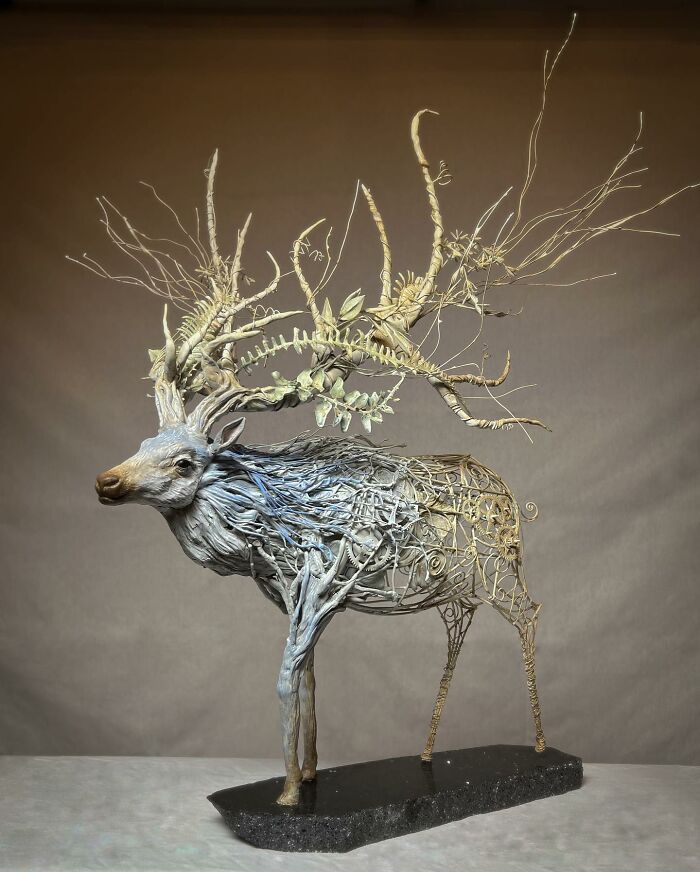
“My favorite junkyard no longer allows artists due to the worry that someone could get injured, so I decided to see what would happen if I left the internal parts out of a sculpture. Luckily, there are still a few more places I can scavenge for parts, but they are becoming fewer and farther between.”
#6
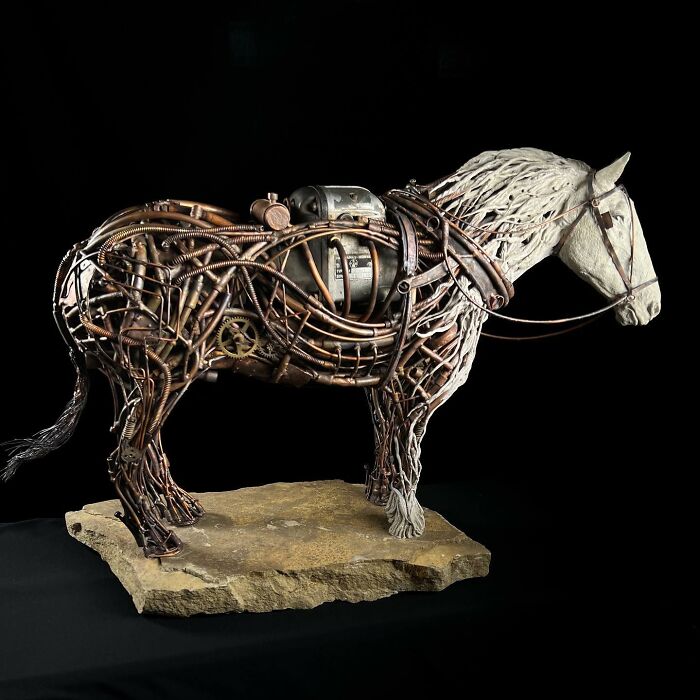
“This sculpture began when I acquired a vintage (1940s) Fairbanks-Morse magneto that came out of a John Deere tractor. While pondering what I could make from this part, the rugged draft horse came to mind. These large horse breeds are durable and able to carry a heavy workload, which makes them popular for farm work or pulling carriages. The magneto, which was once responsible for generating electrical power for the tractor’s ignition system, has been reimagined as part of the horse’s torso. The sleek metal component stands out against the horse’s natural curves and textures, creating a visual interplay between the organic and the industrial. The sculpture is meant to be a testament to the power of human creativity and the beauty that can be found in unexpected combinations. This sculpture would make a striking addition to any art collection or public space, inviting viewers to contemplate the intricate relationship between nature and technology.”
#7
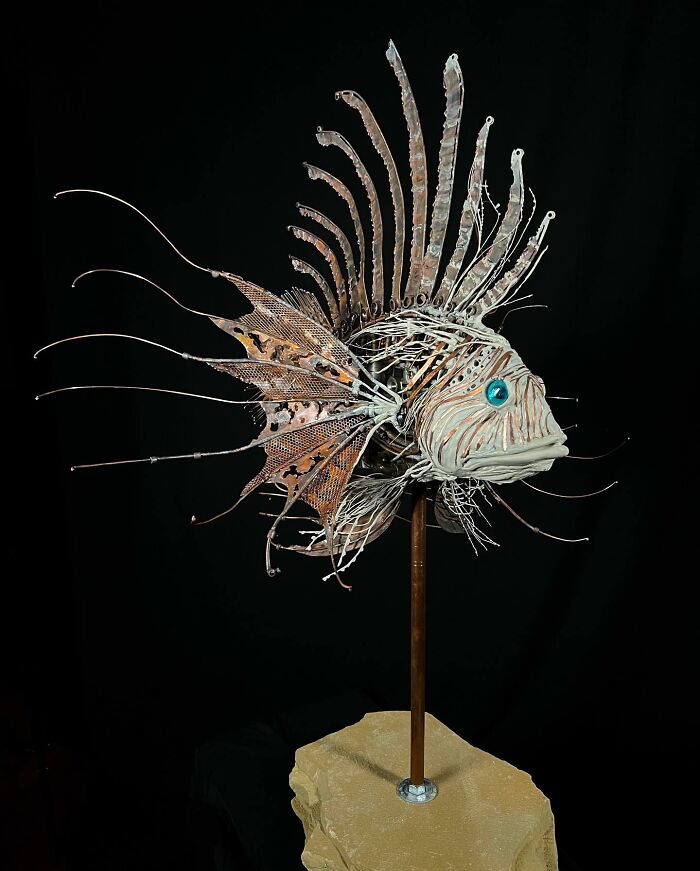
“The lionfish started as a piece from the junkyard, which I had no clue as to its origins. A friend on here told me it was a hydraulic valve control unit from either something like a tractor or maybe one of those crane-type widgets attached to a truck. Always glad to see this community chime in on solving junkyard mysteries. Forgot to get the dimensions before it left the studio for crating, but it’s roughly 24″ in length from nose to tail.”
#8
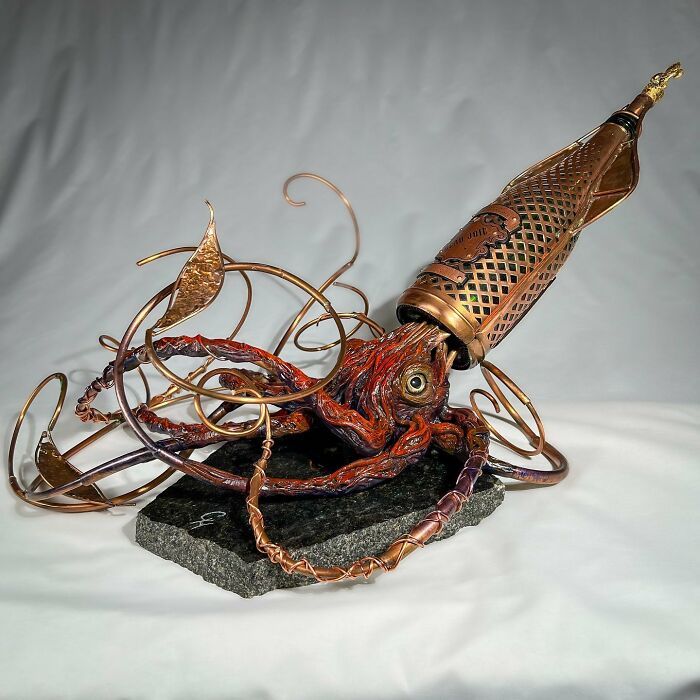
“This piece began as a champagne bottle. The contours of the bottle reminded me of the anatomical portion referred to as the mantle on the common squid. From there, I formed the arms and tentacles that splay out in chaotic discombobulation. This piece was an exercise in texture from the cross-hatched copper champagne casing, to the almost organic way the body of the squid forms ‘vines’ reminiscent of the grapes used to produce the iconic beverage. The topper on the bottle is instantly recognizable as a ‘fleur-de-lis,’ paying homage to the country that created the widely celebrated potable.”
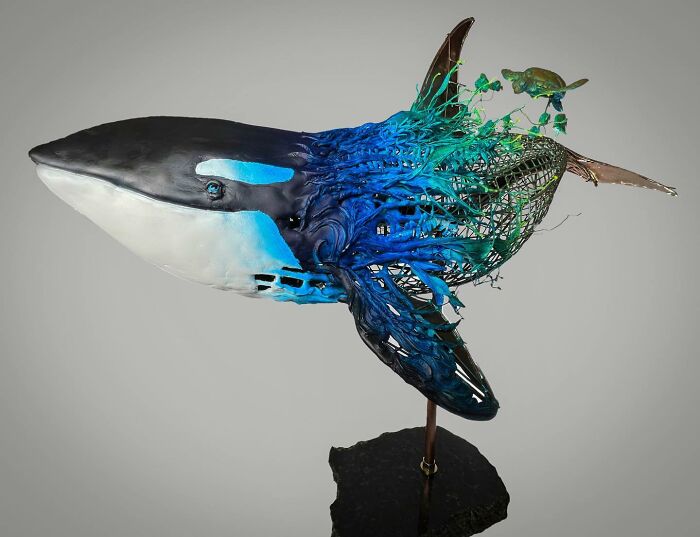
“This piece started out with a clarinet that a friend of mine found. Because of the shape, I seem to gravitate towards these instruments, which are perfect for whales. The clay work transitions into seaweed and coral inspirations and includes various ocean life, including a sea turtle.”
#10
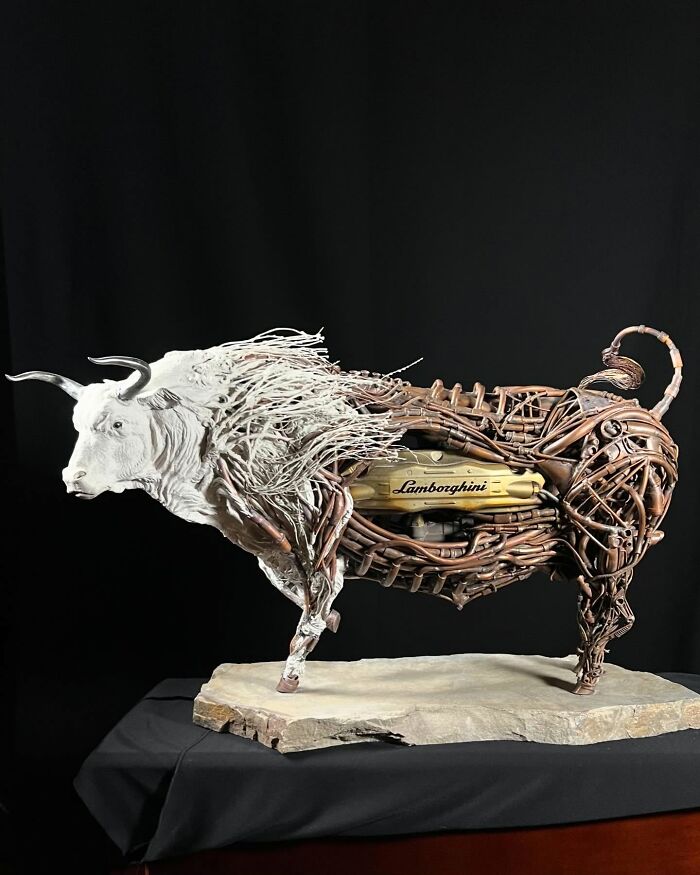
“The use of automotive parts in my sculptures has always been a passion of mine, as I am able to breathe new life into these mechanical components and give them a new purpose as works of art. The horns were forged by my friend Christopher, who is a talented blacksmith in his own right. This piece began with a brake caliper from a Lamborghini. The owner had an engine fire that ultimately totaled the vehicle, so I was fortunate enough to rescue a few parts off of it. Over the course of creating this sculpture, I learned that although Lamborghini is an Italian company, they use Spanish names for their models after names used in bullfighting. The founder, Ferruccio Lamborghini, was so inspired by the strength and resilience of the Spanish fighting bull that he incorporated it into his logo. The title of this piece is ‘El Toro Bravo,’ which is Spanish for ‘The Brave Bull.'”
#11
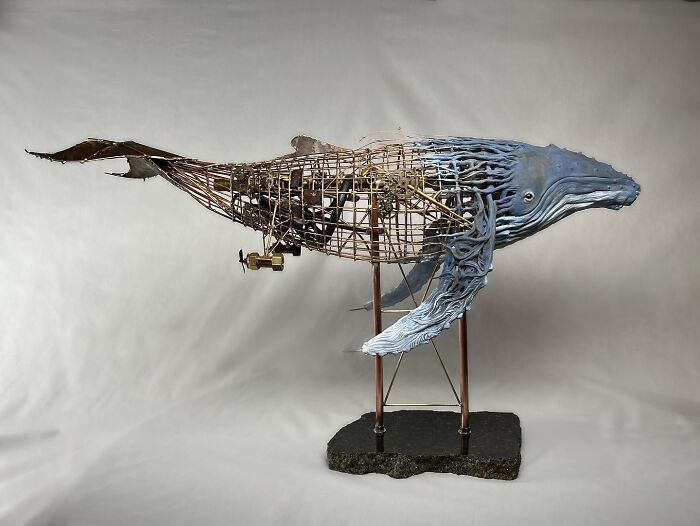
“Humpback whale sculpture completed. This piece began as a sterling silver antique clarinet and is complemented by various parts found in the local scrapyards. Parts used include electrical wiring, small engine parts, plumbing parts, and antique copper flashing. The granite base was recycled from a kitchen countertop.”
#12
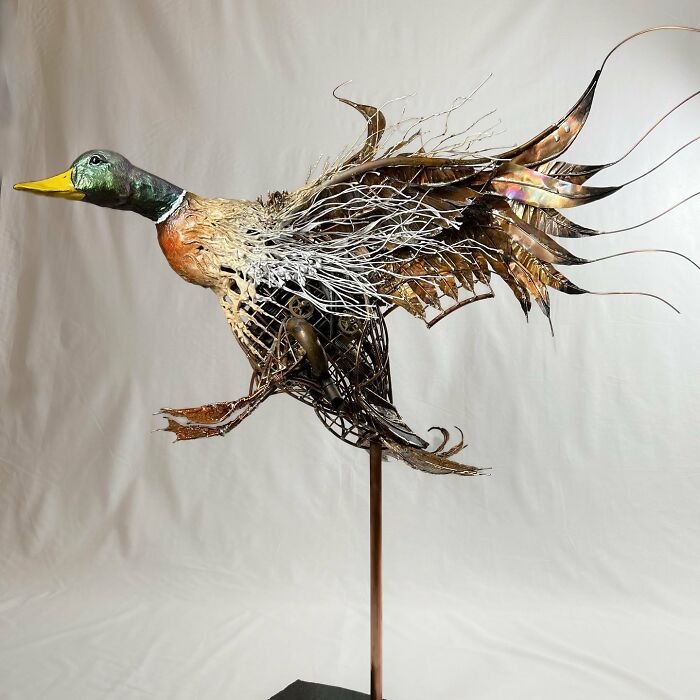
“Commissioned sculpture for a client who is an avid duck hunter. The mallard is a beautiful duck that has iridescent feathers. I used a color shift paint to create the look of those feathers, and I am quite happy with the technique. Depending on the angle one looks at the piece, the head color shifts from green to blue. Internally, parts are procured from the local junk yard. The customer was specific with wanting the mallard to be looking as if it were about to land on water, and I was able to use some strangely colored orange copper for the feet that a friend found at his junkyard.”
#13
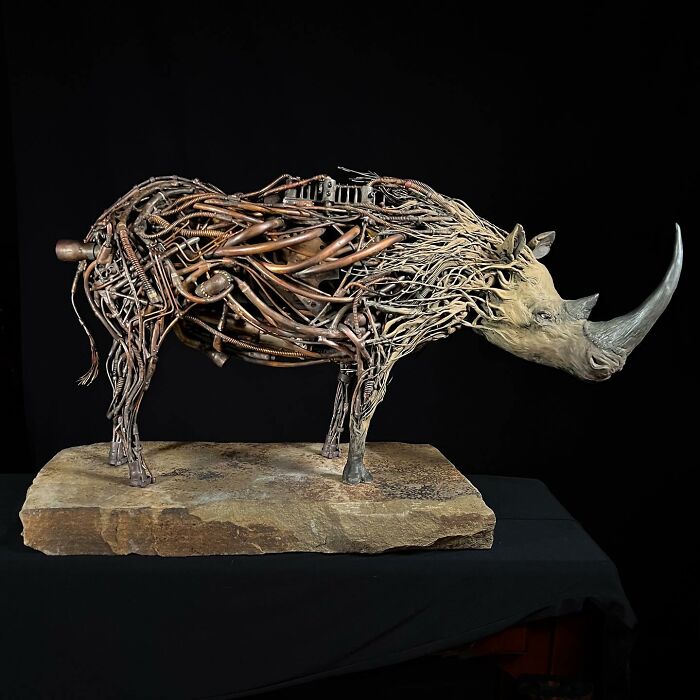
“This is the first sculpture that I used a tig welder for and the first to use a high heat/brazing process. The northern white rhino went functionally extinct in 2018 with the death of the last male named Sudan. The good news is that the story doesn’t end there. BioRescue Project aims to change this by using a team of scientists and biologists to create the first ‘test tube baby’ rhino as early as 2024. While there is no guarantee of success, advancements in the field of stem cell research mean we are closer than ever to bringing a species back from the dead.”
#14
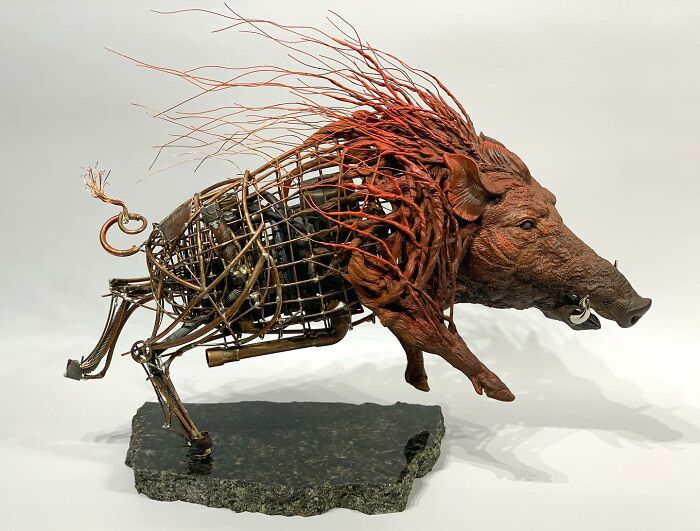
“This one pays homage to my home State. If you are an Arkansan, there’s a pretty good chance you are a fan of the Arkansas Razorbacks, the official mascot for the University of Arkansas. The Razorback was officially adopted as the university’s mascot in 1909 after Hugo Bezdek, the coach at the time, stated after a big win that his team played like a ‘wild band of razorback hogs.’ I wanted to capture this beast at full throttle, so it has three of its four legs in the air as it charges forward with flowing lines that convey a sense of movement and speed. The entire sculpture is supported by a 3/8th steel rod, and of course, dual ‘exhaust pipes,’ because a beast this powerful wouldn’t be running on a four banger. This sculpture represents what I intend to work into what I’m calling the University Sculpture Series (USS). Maybe a Tiger or a Bulldog coming in the future? Whatever may come, this first offering is titled USS Razorback.”
#15
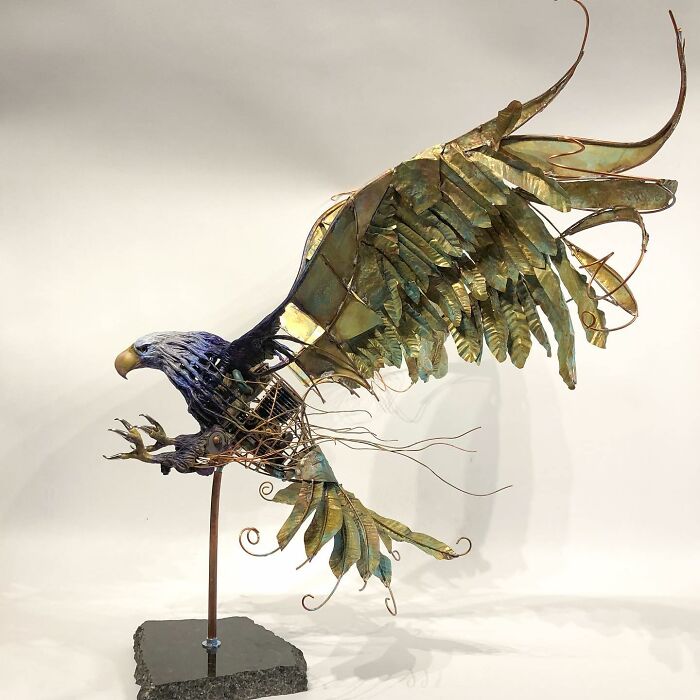
“This piece was designed using a combination of mixed media and found objects. The journey begins at the junkyard, scavenging for interesting parts. In this case, small engine pieces for the interior of the body and rocker arms from an automobile for the legs combine to form the scaffold of the sculpture. This sculpture, like many of my recent works, utilizes mixed media to balance the cold metal of the found objects with the warmth of sculpted ‘flesh,’ creating a visible transition from organic to inorganic.”
